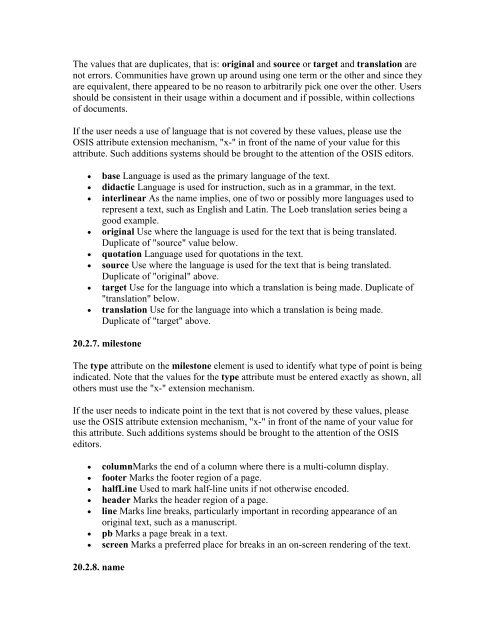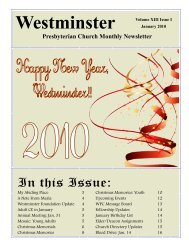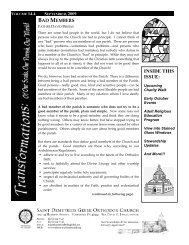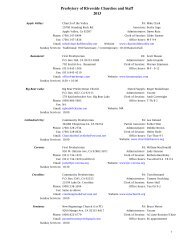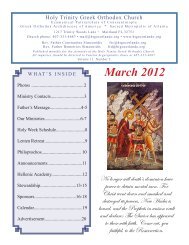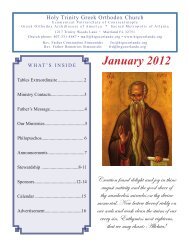OSIS? 2.0.1 User's Manual - Web services are running on AMBIB
OSIS? 2.0.1 User's Manual - Web services are running on AMBIB
OSIS? 2.0.1 User's Manual - Web services are running on AMBIB
Create successful ePaper yourself
Turn your PDF publications into a flip-book with our unique Google optimized e-Paper software.
The values that <str<strong>on</strong>g>are</str<strong>on</strong>g> duplicates, that is: original and source or target and translati<strong>on</strong> <str<strong>on</strong>g>are</str<strong>on</strong>g><br />
not errors. Communities have grown up around using <strong>on</strong>e term or the other and since they<br />
<str<strong>on</strong>g>are</str<strong>on</strong>g> equivalent, there appe<str<strong>on</strong>g>are</str<strong>on</strong>g>d to be no reas<strong>on</strong> to arbitrarily pick <strong>on</strong>e over the other. Users<br />
should be c<strong>on</strong>sistent in their usage within a document and if possible, within collecti<strong>on</strong>s<br />
of documents.<br />
If the user needs a use of language that is not covered by these values, please use the<br />
<str<strong>on</strong>g>OSIS</str<strong>on</strong>g> attribute extensi<strong>on</strong> mechanism, "x-" in fr<strong>on</strong>t of the name of your value for this<br />
attribute. Such additi<strong>on</strong>s systems should be brought to the attenti<strong>on</strong> of the <str<strong>on</strong>g>OSIS</str<strong>on</strong>g> editors.<br />
• base Language is used as the primary language of the text.<br />
• didactic Language is used for instructi<strong>on</strong>, such as in a grammar, in the text.<br />
• interlinear As the name implies, <strong>on</strong>e of two or possibly more languages used to<br />
represent a text, such as English and Latin. The Loeb translati<strong>on</strong> series being a<br />
good example.<br />
• original Use where the language is used for the text that is being translated.<br />
Duplicate of "source" value below.<br />
• quotati<strong>on</strong> Language used for quotati<strong>on</strong>s in the text.<br />
• source Use where the language is used for the text that is being translated.<br />
Duplicate of "original" above.<br />
• target Use for the language into which a translati<strong>on</strong> is being made. Duplicate of<br />
"translati<strong>on</strong>" below.<br />
• translati<strong>on</strong> Use for the language into which a translati<strong>on</strong> is being made.<br />
Duplicate of "target" above.<br />
20.2.7. milest<strong>on</strong>e<br />
The type attribute <strong>on</strong> the milest<strong>on</strong>e element is used to identify what type of point is being<br />
indicated. Note that the values for the type attribute must be entered exactly as shown, all<br />
others must use the "x-" extensi<strong>on</strong> mechanism.<br />
If the user needs to indicate point in the text that is not covered by these values, please<br />
use the <str<strong>on</strong>g>OSIS</str<strong>on</strong>g> attribute extensi<strong>on</strong> mechanism, "x-" in fr<strong>on</strong>t of the name of your value for<br />
this attribute. Such additi<strong>on</strong>s systems should be brought to the attenti<strong>on</strong> of the <str<strong>on</strong>g>OSIS</str<strong>on</strong>g><br />
editors.<br />
• columnMarks the end of a column where there is a multi-column display.<br />
• footer Marks the footer regi<strong>on</strong> of a page.<br />
• halfLine Used to mark half-line units if not otherwise encoded.<br />
• header Marks the header regi<strong>on</strong> of a page.<br />
• line Marks line breaks, particularly important in recording appearance of an<br />
original text, such as a manuscript.<br />
• pb Marks a page break in a text.<br />
• screen Marks a preferred place for breaks in an <strong>on</strong>-screen rendering of the text.<br />
20.2.8. name


